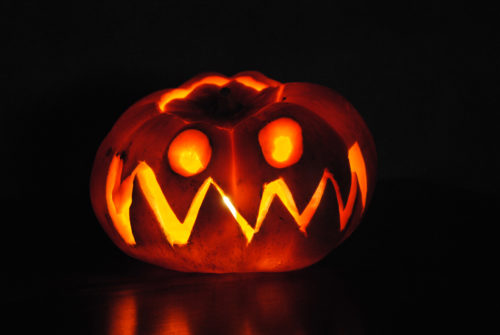Happy Halloween!
Ever wondered about the origins and significance of Halloween? Is it, as some people claim, a celebration of demons, devils, and darkness that rivals even the depravity of Dungeons & Dragons?
Grab your favorite villain costume and a few jack o’ lanterns, because we’re going to take a brief look at the history of Halloween.
In days of yore, the Celtic people celebrated Halloween as the end of the fall and harvest, and the advent of the cold, desolate winter. Life slipped into death as the trees lost leaves. The world turned white, gray, and black. The Celts called it Samhain, pronounced sow-in or sow-een.
The holiday was never about celebrating evil. It was in fact the opposite. It was thought that the spirits of the dead passed between worlds on this night. People carved pumpkins to ward off evil. This is much like the gargoyles that sat on the corners of cathedrals to ward off demons.
On this night, Druids communicated with the Otherworld to make predictions that would guide the people for the year. In addition, they built bonfires, originally called bone fires, where they would offer animal and crop sacrifices to appease the deities.
Samhain was very much a community event. The Celts wore animal skins as costumes while at the fire, possibly to ward off evil or honor the spirits. Then everyone would light the hearth fires with the flames of the bone fire.
Samhain offered hope to the people, fortifying them for the coming drudgery of winter. The cold months were lean times. If you’ve ever lived in northern climes, you’ll understand how long and hopeless the winter feels. In the spring, Samhain’s opposite dawned: Beltane. It would welcome the warm months of greenery and life.
The More Things Change…
The holiday has evolved over the years. In the first century AD, the Romans modified Samhain, combining it with their festival of honoring the dead and the goddess of fruit and trees. In the seventh century, Pope Boniface IV established the feast of All Martyrs Day on November 1st. All Souls Day happened November 2nd. People celebrated with…costumes, parades, and bonfires.
Today, Halloween is primarily an American holiday. It started in Colonial days, when European traditions blended with Indian lore. People shared stories of the dead, had fires, shared food, played tricks, and generally celebrated the passing of another harvest year. The influx of immigrants from Celtic areas encouraged the rise of Halloween as we know it: Not until the mid 1800s did trick-or-treating appear and the celebration of Halloween become national.
Today’s Traditions: Evil or Otherwise?
No longer is Halloween a celebration of the changing seasons. It’s about community and fun, yes, but it’s primarily a chance to escape normalcy with its drudgery – if only for a night.
We dress up in costumes to be who we aren’t. No longer does the world see us as [insert stereotype/profession/etc here]. The world makes judgments about us based on first glance, but unlike every other day, now people know those judgments are unreliable. On Halloween, the surface may match the heart more – or less. At least the outside gives a different point of reference other than our usual unchangeable or almost unchangeable features.
Being in a different form helps us see the world differently. We feel a bit of the character we’re playing. Maybe that means we feel more confident, assertive, or even witty. Being in costume improves a person’s mood, that’s for sure! It also gives us a point of common interest with others. If you see a person in a costume you like, you’re apt to feel friendly toward them. You might even strike up a conversation about it.
We go to haunted houses to have a safe adrenaline rush. Being scared is fun if you know you’re not really in danger. Life gives us stress, but it doesn’t give us the dangers we used to face. Thus it also robs us of the rewards we felt after conquering those dangers. Now we get a taste of that primal thrill after we “escape” Howl-O-Scream.
By pretending to be denizens of the dark, we can feel a thrill from doing what’s normally taboo. Yet at the same time, we fit in, because ‘tis the season to enjoy the fun parts of the dark and dismal domains. We can have giant spider webs without the spiders, slime without the slugs, skulls without the death, and blood without its annoying tendency to dry too quickly.
Halloween is a holiday tailor-made for villains. It exemplifies why we love villains: freedom, power, respect, and confidence. On Halloween, we can step out of our bland selves and into the skin of villains. Then November 1st dawns, and all will seem but a mid-summer night’s dream.
Halloween amounts to a time of not only fun, but also of catharsis. As in the days of old, we use it as a time to end one season and begin another. Halloween puts to rest spirits of the past while encouraging our spirits for the future. We look ahead at a season of holidays, and beyond that a new year of change and possibility. We know the dark days will come, be they winter’s or life in general’s trials. But soon Beltane will come, and with it spring. Until then, let’s enjoy this time of transition as we prepare for the opportunities that await.
